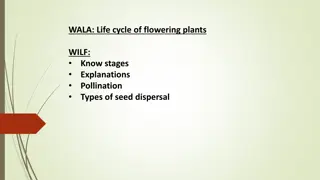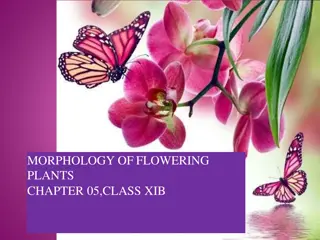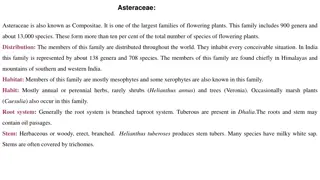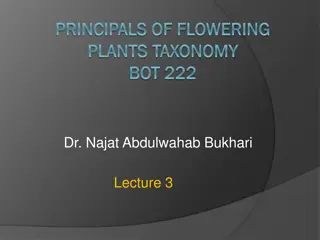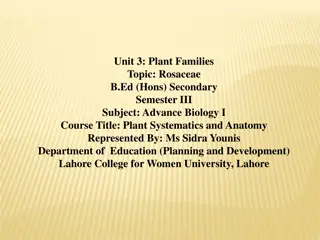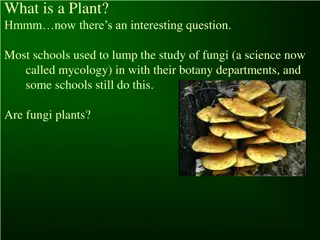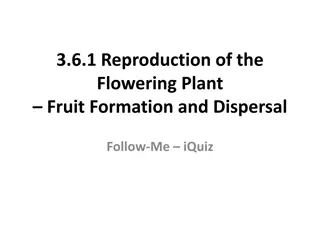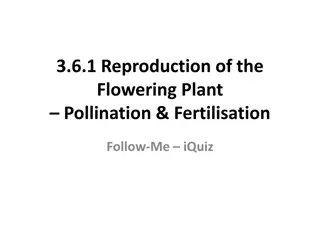Asteraceae: The Composite Family of Flowering Plants
Asteraceae, commonly known as the Composite family, is a diverse group of plants with over 1,620 genera and 23,600 species worldwide. This family is recognized for its ornamental garden plants like Asters, Chrysanthemums, and Dahlias. With a unique characteristic of flower heads composed of small florets surrounded by bracts, Asteraceae exhibits varied vegetative and floral features that make it a prominent plant family in plant systematics and anatomy studies.
Download Presentation

Please find below an Image/Link to download the presentation.
The content on the website is provided AS IS for your information and personal use only. It may not be sold, licensed, or shared on other websites without obtaining consent from the author. Download presentation by click this link. If you encounter any issues during the download, it is possible that the publisher has removed the file from their server.
E N D
Presentation Transcript
Unit 3: Plant Families Topic: Asteraceae B.Ed (Hons) Secondary Semester III Subject: Advance Biology I Course Title: Plant Systematics and Anatomy Represented By: Ms Sidra Younis Department of Education (Planning and Development) Lahore College for Women University, Lahore
INTRODUCTION Asteraceae, also called Composite, the aster, daisy, or composite family of the flowering-plant order Asterales. With more than 1,620 genera and 23,600 species of herbs, shrubs, and trees distributed throughout the world, Asteraceae is one of the largest plant families. Asteraceae is important primarily for its many garden ornamentals, such as Artemisia, Asters, Chrysanthemums, Cosmos, Dahlias, Tagetes and Zinnias. Members of the family have flower heads composed of many small flowers, called florets, that are surrounded by bracts (leaf like structures). The leaves of Asteraceae are simple or occasionallycompound, and their arrangement along the stem may be opposite, alternate, or, less commonly, whorled; not infrequently they are opposite toward the base of the stem and alternate above.
DISTRIBUTION OF ASTERACEAE: This family is commonly known as Sunflower family. It is the largest family of dicotyledons, comprising 950 genera and 20,000 species, out of which 697 species occur in India. The members of this family are found chiefly in Himalayas and mountains. They are worldwide in distribution and abundant in tropics and in cold arctic or alpines regions. MORPHOLOGY OF ASTERACEAE: Asteraceae has mostly herbs or shrubs or rarely trees; leaves alternate rarely opposite, exstipulate rarely stipulate; inflorescence capitulum or head surrounded by involucre of bracts; ray and disc florets, flower tubular or ligulate, flowers bi- or unisexual or outer male or female, pentamerous, actinomorphic or zygomorphic, caryxpappus, corolla gamopetalous, petal lobes 5, stamens 5, epipetalous, usually dithecous, filament free and anthers united i.e. syngenesious, introrse, ovary unilocular, inferior, with basal placentation, style slender stigma bifid; fruit cypsela.
VEGETATIVE CHARACTERS: Habit: Habit includes annual or perennial herbs or small shrubs. Trees are rarely present which are small or climbers. Many of the plants are xerophytes, hydrophytes some are semiaquatic. Roots: Fibrous tap root is present in sunflower. A fibrous root system is the opposite of a taproot system. It is usually formed by thin, moderately branching roots growing from the stem. Stem: Asteraceae stem is Herbaceous, spiny or without spines, cylindrical, hair, Erect, or prostrate, woody, sometimes with latex. Stem tubers are also present. Tubers are edible, cylindrical, glabrous, solid or fistular, stem may be leaf-like. Leaf: Leaves may be radical, petiolateor sessile, exstipulate, mostly simple sometimes scale-like. Also alternate rarely opposite or whorled.
FLORAL CHARACTERS: Inflorescence: The floral character includes inflorescence which is a racemose head or capitulum. It is terminal or axillary in position. In some species several heads aggregate to form compound head or umbleor panicle. Each head is subtended by an involucreof green membranous bracts which are protective in function. The flowers of this inflorescence are called florets. Number of florets in the head varies from few to many. Sometimes only single florets are present as in Echinopus. The flowers are open in acropetal succession. The florets are borne on a flat, concave or convex receptacle. Each floret is subtended by a receptacular bract called palea. Flower: Flowers are bracteates, sessile, bisexual (sometimes unisexual or neutral), pentamerous, epigynous. The form of flowers may vary in head and the head may be homogamousor heterogamous.
Homogamous: All the florets are alike in structure and function. They are bisexual and either regular (Veronica) or liguate (Cichorium). Heterogamous: Florets in heterogamous heads are of two types described below, 1: Disc florets: They are centripetally arranged complete florets. The florets are bracteate, actinomorphicand bisexual, tubular and epigynous. They do not possess any extra-appendage. So, this floret is illigulate. Calyx: Calyx is absent or modified into pappus. Corolla: Sepals 5 in number, Gamosepalous, tubular. Androecium: Stamens 2, epipetalous, syngenesious dithecous. Gynoecium: Bicarpellary, Syncarpous, unilocular, one ovule, on basal placentation style single, stigma bifid.
2: Ray florets They are peripherally placed incomplete florets. The florets are zygomorphic and unisexual or neutral. This helps in increasing the attraction of the flower. They possess extra appendages called ligule. So, this floret is ligulated. Calyx: It is absent or hairy pappus or scaly persistent. Corolla: Petals 5 in number, polypetalous, ligulate. Androecium: Androecium is absent. Gynoecium: Bicarpellary, syncarpous, unilocular, one ovule, the locule, basal placentation, style narrow and stigma branched, ovary inferior.
Seed and fruit: Seeds are non-endospermic with straight embryo. Fruit is a Cypsela which is dispersed by pappus hairs (Taraxacum). In Xanthium the fruits are dispersed by animals due to presence of hooks. POLLINATION IN ASTERACEAE: Pollination in family Asteraceae is done by a variety of insects. IMPORTANT GENERA OF ASTERACEAE: Helianthus annus (Sunflower) Calendula officinalis (English marigold) Sonchus asper (Spiny sow thistle) Tagetes erecta (Gandha)
ECONOMIC IMPORTANCE OF FAMILY ASTERACEAE 1. Food: Leaves of Lactuca sativa are used as salad. The roots of Helianthus tuberosusare edible. 2. Oil: The seeds of Helianthus and Artemisia yield oil. 3. Medicinal: The roots of Taraxacum used in bowel disorders. The juice of Emillia sonchifolia leaves has cooling effect and is used in eye inflammation and also for night blindness. Eclipta alba used as tonic in spleen enlargement. Calendula Officinalis is used for treating sore throat and mouth, cancer and ulcers. 4. Rubber: It is obtained from Solidago and Taraxacum.
5. Insecticide: The capitula of Chrysanthemum spp. is dried, powdered and used as insecticide. 6. Ornamental: Zinnia, Dahila, Cosmos, Chrysanthemum, Calendula, Helichrysium, Aster, Helianthus, Tagestes etc. are well known garden plants.






